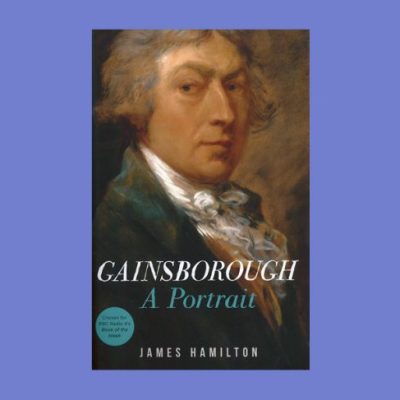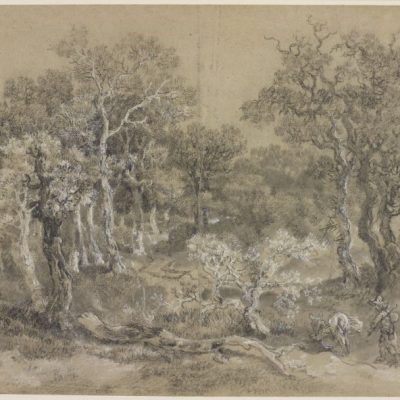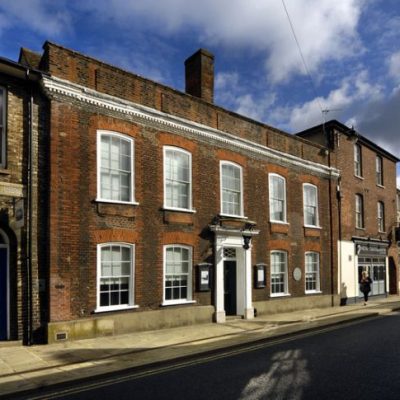Among the portraits Thomas Gainsborough painted while living in Bath is a small likeness of a young boy in shirt and waistcoat, clutching a handful of paintbrushes and glancing anxiously out of the feigned oval in which he’s framed. The boy – dubbed ‘the Pitminster Boy’, for the small Somerset village he came from – was one of Gainsborough’s studio assistants, a local lad who used to carry the artist’s materials and pass him brushes when he went into the countryside to paint landscapes. The portrait is hastily done, but the expressiveness Gainsborough captures in the boy’s face – the hesitation around the selection of a brush – indicates the remarkable attention he paid to the way people around him looked.
‘The Pitminster Boy’ (late 1760s), Thomas Gainsborough

‘The Pitminster Boy’ (late 1760s) is one of about 50 portraits of family and household members that Gainsborough painted or drew between the 1740s and his death in 1788, brought together for the first time in the National Portrait Gallery’s exhibition ‘Gainsborough’s Family Album’. The sheer size of the collection, divided into the Suffolk, Bath and London phases of the artist’s career, makes it extraordinary. Gainsborough painted seven likenesses of his wife; his daughters, together or separately, appear in more than 10; there are pictures of his father, his brothers, his sister and brother-in-law, his nephew, his pet dogs. Collectively the portraits are perhaps the only full pictorial record we have of a middle-class family before the advent of photography, depicting a network of ordinary people at a time when possessing a likeness of oneself was a luxury available only to the nobility and gentry.
There were good practical reasons for painting them. Eighteenth-century portraitists rarely had the time or inclination to produce uncommissioned pictures of loved ones, but Gainsborough found commercial uses for the intimacy of family portraiture. There were few better ways to advertise his skill at capturing likenesses than having in the studio where he received potential clients pictures hanging of people who were likely to be nearby. The pendants he painted of himself and his wife Margaret around the time they moved to Bath – a self-portrait of c. 1758–59 and Margaret Gainsborough, the Artist’s Wife (c. 1758) – are likely to have had this publicising function, and the more so because they pictured the couple as the sort of people who would ordinarily have their portraits painted, the confident country gentleman and his fashionable wife draped in silks. When the family moved to a grand house on Pall Mall in 1774, Gainsborough produced Mary and Margaret Gainsborough, the Artist’s Daughters, a formal full-length double portrait in which artistic and social ambitions are united. Mary’s gauzy sleeve, threaded through with gold and made transparently fine to reveal her forearm beneath, signals both her own refined tastes and her father’s consummate skill.
Mary and Margaret Gainsborough, the Artist’s Daughters, Playing with a Cat (c. 1760–61), Thomas Gainsborough. National Gallery, London

For Gainsborough, there was a great sense of freedom involved in painting portraits he hadn’t been contracted for. The things that irritated him about commercial portraiture – the demands of clients, the conventional requirements – weren’t factors when it came to depicting his studio apprentice or the family spaniel, and he felt able to experiment. Mary and Margaret Gainsborough, the Artist’s Daughters, Playing with a Cat (c. 1760–61), for instance, is a half-finished picture of the sisters teasing a barely sketched cat, the rapid strokes and incomplete passages showing off a brilliant carelessness in the artist’s technique. Another picture Margaret modelled for during the same period, Margaret Gainsborough, the Artist’s Daughter, as a Gleaner (c. 1760–61), shows Gainsborough experimenting with the ‘fancy picture’, a contemporary genre that presented figures – often children – playing out imaginary or historical roles. Margaret is cast as a peasant girl in modest country dress, her head downcast over her sheaf of grain and a lowering sky behind her suggesting the urgency of her task. The picture, though, is a curious mix of genre painting and portraiture: there’s something non-conventional and specific about the slight challenge in her stare and the turn of her mouth, as if the strength of her character (Gainsborough used to call her ‘the captain’) is coming out around the edges. In The Harvest Wagon (1767), her bright black shoes with their gold buckles gleam out rebelliously from the green and brown rustic scene in which she’s placed.
Gainsborough Dupont, the Artist’s Nephew (1773), Thomas Gainsborough. Waddesdon Manor, Buckinghamshire

Gainsborough’s other favourite model was his nephew, Gainsborough Dupont, who joined his household as a young boy and then became his apprentice. Dupont was the son of a carpenter, the plain-looking Philip Dupont whom Gainsborough painted in unfashionable working clothes and no wig in an oval of the 1770s. There is nothing of the father in Gainsborough’s likenesses of the nephew: Gainsborough Dupont, the Artist’s Nephew (1773) transforms the teenager into a Caroline nobleman, his delicate features, flowing chestnut hair, pointed lace collar and rich blue doublet straight out of a Van Dyck court painting.
Margaret Gainsborough, the Artist’s Wife (c. 1777), Thomas Gainsborough. Courtauld Gallery, London

These are ambitious, suggestive portraits in an age when portraiture was often more commercial than intellectual. A star of the show is Margaret Gainsborough, the Artist’s Wife (c. 1777): the 50-year-old Margaret, cloaked in black satin and lace, gazes frankly at her husband behind the easel with an expression that falls somewhere between tenderness and reproach, or takes in both. Portraits of Gainsborough’s two brothers – Humphrey, the sober churchman, and John (‘Scheming Jack’), a financial leech and would-be inventor who tried to fly on copper wings, here depicted with wet pink alcoholic eyes and thin plastered hair – hang side by side as a kind of morality tale. The exhibition is a lively, tender celebration of Gainsborough’s developing style, and of the way he used it to capture the faces of people who wouldn’t otherwise have made it into paint.
‘Gainsborough’s Family Album’ is at the National Portrait Gallery, London, until 3 February.
From the January 2019 issue of Apollo. Preview and subscribe here.



